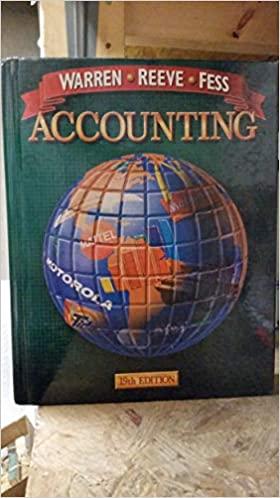Answered step by step
Verified Expert Solution
Question
1 Approved Answer
only need answer to C & D California Circuits Company (3C) manufactures a variety of components. Its Valley plant specializes in two electronic components used
only need answer to C & D 





California Circuits Company (3C) manufactures a variety of components. Its Valley plant specializes in two electronic components used in circuit boards. These components serve the same function and perform equally well. The difference in the two products is the raw Inaterial. The XLD chip is the older of the two components and is made with a metal that requires a wash prior to assembly. Originally, the plant released the wastewater directly into a local river. Several years ago, the company was ordered to treat the wastewater before its release, and it installed relatively expensive equipment. While the equipment is fully depreciated, annual operating expenses of $250,000 are still incurred for wastewater treatment. Two years ago, company scientists developed an alloy with all of the properties of the raw materials used in XL-D that generates no wastewater. Some prototype components using the new material were produced and tested and found to be indistinguishable from the old components in every way relating to their fitness for use. The only difference is that the new alloy is more expensive than the old raw material. The company has been test-marketing the newer version of the component, referred to as XL-C, and is currently trying to decide its fate. Manufacturing of both components begins in the Production Department and is completed in the Assembly Department. No other products are produced in the plant. The following provides information for the two components: information for the two components: XL-D 100,000 $12 XL-G 25,000 $14 Units produced Direct material costs per unit Direct Labor Information Direct labor-hours per unit_Production Direct labor-hours per unit-Assembly Direct labor rate per hour...all labor Other Activity Information Machine-hours per unit Production Machine-hours per unit... Assembly Testing hours per unit Shipping weight per unit (pounds) Wastewater generated per unit (gallons) 0.1 10.4 $20 10.1 0.4 $20 1,6 10.4 3.0 1.0 10.0 1.6 10.4 3.0 1.6 0.0 Annual overhead costs for the two departments follow: Production Department $1,050,000 Assembly Department $500,000 The company president believes that it's foolish to continue producing two essentially equivalent products. At the same time, the corporate image is somewhat tarnished because of a toxic dump found at another site (not the Valley plant). The president would like to be able to point to the Valley plant as an example of company research and development (R&D) working to provide an environmentally friendly product. The controller points out to the president that the company's financial position is shaky, and it cannot afford to make products in any way other than the most cost-efficient one. C. The company decides to compute product costs assuming they implement an Activity Based Costing (ABC) system. The company first assigns all overhead to one of six cost pools. The overhead cost pools and the cost drivers selected for those cost pools are: Overhead Cost Pool Supervision Material Handling Testing Wastewater treatment Equipment depreciation Shipping Cost Pool Total $ 340,000 $ 133,000 $ 150,000 $ 300,000 $ 500,000 S 127,000 Cost Pool Driver Direct labor hours Direct material cost Testing hours Wastewater generated (gal) Machine hours Weight (pounds) What would the per unit product cost be reported for each product if this ABC system were implemented? Assume that the production mix and costs would remain as originally planned. Use the tab "Requirement in the Excel template to answer this question. Set up a chart similar to Exhibit 9.16 in the textbook (see page 368) to show your answer. Do not round intermediate calculations. You must show the work of your calculations, so you must use cell referencing to set up the elements in your chart. D. Please briefly discuss the advantages and disadvantages of the three cost allocation methods above, including traditional single plantwide rate cost allocation, two-stage departmental allocation, and activity-based costing. What is your suggestion for the president if you were the controller? Write you answer on a Word document that you will submit to the assignment submission on Blackboard. H C G D XLC XL-D $1,200,000 XL- $350,000 XLD 100 000 Total 25,000 125X Number of units 40,000 10.000 1.000.000 $2,200,000 10,000 2,500 $25000 $600,000 Machine Hours Machine Broductions Direct met Directory Direct Labor Production De Lobo Total Total direct cost 3.000 160 000 $1.200.000 30.000 10 $1.000.000 53700.000 30.000 0.000 $350.000 10,000 200 52500 100.000 90 200.000 $1.000 KO 12.500 51.350.00 $2.000 5 A 1 2 Direct Materih 4. Direct Labor 5 Assembly Production 7 Totalect Labor 11 Dect Com 9 Overhead 10 Assembly building Assembling op MH 12 Setting up Machine Setup hour 13 Handling Material 10000 per un 14 Packing ding Inspecting and Production per direct labor hour 16 Shipping 1,120 per shipment 17 Total ABC overhead 18 Total ABC Cou 19 Number of Units 20 Unit Cost 21 22 23 24 25 26 27 20 Overhead con Asunny Noduction You love Torel Core 10.000 0000 1.550.000 450.000 Overhead Cow Pool SV Material Handling Testin Wamewater treatment Lideration Shipping Cost Pool Total Cost Pool Driver S140000 Dect later hours $111.000 Direct material cos 5150000 Testing hours $100.000 Wastewater meted a $500,000 Machine her $127.000 Welon pound 





Step by Step Solution
There are 3 Steps involved in it
Step: 1

Get Instant Access to Expert-Tailored Solutions
See step-by-step solutions with expert insights and AI powered tools for academic success
Step: 2

Step: 3

Ace Your Homework with AI
Get the answers you need in no time with our AI-driven, step-by-step assistance
Get Started


